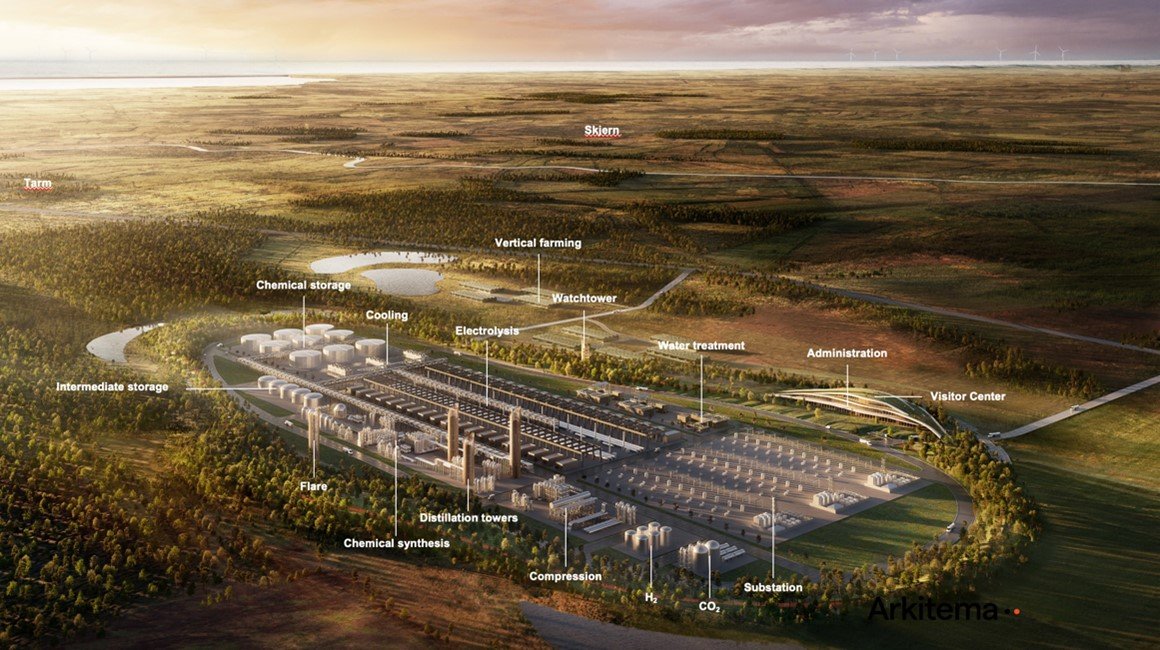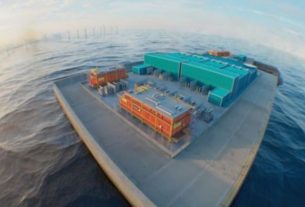Denmark – A green energy park being developed by GreenGo Energy and Ringkøbing-Skjern Municipality will provide 2GW of electrolysis and 4GW of hybrid solar and wind energy.
The Energy Park will be located in the Ringkøbing-Skjern municipality’s Stovstrup 400kV substation, which is east of Tarm.
One of the biggest fully integrated energy parks in the world, Megaton, will annually produce more than 1 million tons of green fuels. The project might make Denmark a pioneer in the hydrogen economy and P2X sector. In order for Denmark to achieve its 2030 goals before 2030, the Energy Park and fully integrated renewable energy projects can help.
At DKK 60 billion or 8 billion EUR, Megaton will cost more than two Storebaelt (Great Belt) bridges. 300-500 local permanent jobs will be created through the Energy Park, renewable energy efforts, and spin-off businesses from byproducts like surplus heat.
Some of the leading investors in infrastructure and renewable energy in the world are among GreenGo Energy’s clients and partners. The Megaton Consulting Engineering team of GreenGo Energy consists of the P2X specialists Arkitema, the offshore wind energy specialists New Power Partners, and COWI.
Scale and control over sufficient renewable energy at the right cost are prerequisites for viable P2X ventures. Renewable energy output needs to be evenly distributed throughout the year in order to maximize electrolysis with a high constant capacity factor. This requires the ideal ratio of sun and wind.
Thus, Megaton starts with GreenGo Energy’s development portfolio, which consists of 2GW of offshore wind from Denmark’s open-door program and 4,000 hectares of onshore solar and wind projects in the municipality. The Ringkbing-Skjern municipality and neighborhood stakeholders will evaluate the final sites for the energy-producing assets during the next months. Megaton electrolysis may be adjusted year-round in the Ringkbing-Skjern municipality by adjusting the solar and wind production profiles.
The 11.5 TWh of green energy generated by the 4GW solar and wind projects will account for more than 30% of Denmark’s total energy consumption. Over 85% will be used at the Megaton Energy Park to produce green fuels.
New standard
An infrastructure project of this scale will benefit the surrounding area of Ringkøbingin several new ways, assist Denmark in its transition, and directly contribute to the 2030 target of a 70% CO2 emission reduction.
The district heating system in the area will be expanded thanks to the project’s excess heat, which is expected to total more than 1TWh. This will guarantee a cheap and environmentally friendly source of heat for the long-term benefit of a significant number of the municipality’s people. The current city plan permits emerging industries like greenhouses and vertical farming to make use of excess heat and clean energy generated by a variety of new wind and solar parks on land and in the water.
Last but not least, alternatives for long-term local co-ownership and anchoring are being created. The components of the municipality and the solution will be specified over time to optimize value.
GreenGo Energy will issue project shares locally in a novel way to ensure local co-ownership. Models for local value generation will be produced by the project.
East of Tarm, on a 350-hectare location that the municipality has designated for energy-intensive businesses like P2X and the forthcoming Stovstrup 400kV substation, GreenGo Energy has been collaborating with the landowners and neighbors.
Strategic location at a major substation for the country On sunny days, wind can be used to balance off massive amounts of energy and overproduction, but you can also use direct lines to transport all of the production from the associated solar and wind parks directly to your power plant and use it in the Energy Park.
Municipal strategy
Leading municipality in the green transition is Ringkøbing-Skjern. The municipality wants new power generation plants to be versatile and value-creating because it has expertise establishing wind farms, solar parks, and biogas plants.
By 2030, Denmark intends to build 4-6 GW of electrolysis capacity and treble its land-based green electricity production. These objectives are furthered by Megaton Energy Park. The innovative Energy Park design and integration concept by COWI and Arkitema interacts with the neighborhood master plan.
To construct an organically curved “P2X atoll,” a hilly island landscape that shields the Energy Park from views in the otherwise flat environment with agriculture and woodland, any extra soil will be used to develop a mountainous terrain landscape surrounding the Energy Park.
The hillside surrounding the plant is covered in spruce, pine, grass, and wildflowers, which encourage biodiversity and provide a stunning landscape.
By adding nature trails, mountain bike routes, playgrounds, and a lookout tower with a view of the Energy Park’s energy generation—a crucial part of the park—the proposal supports Skjern and Tarm’s vision and master plan. Everything looks attractively green as a result.
Due to the Energy Park’s initial construction and design, which aimed to maximize the use of renewable resources and electrolysis efficiency, offshore wind makes up a sizable portion of the wind farm’s energy mix. Due to the size of the Megaton Energy Park, new approaches to community engagement and value maximization with consideration for the environment were required.




